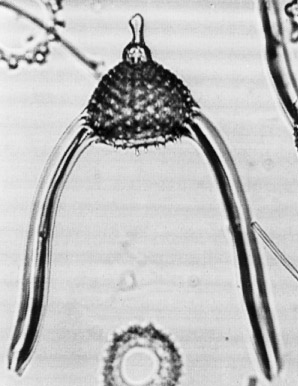 Lychnocanoma
elongata (Vinassa de Regny)
Lychnocanoma
elongata (Vinassa de Regny) Lychnocanoma
elongata (Vinassa de Regny)
Lychnocanoma
elongata (Vinassa de Regny)Tetrahedrina elongata Vinassa de Regny, 1900, p.243, pl.2, fig.31
Lychnocanium bipes Riedel, 1959, p.294, pl.2, figs.5-6
Lychnocanoma elongata (Vinassa de Regny), Sanfilippo et al., 1973, p.221, pl.5, figs.19-20 (with synonymy)
Cephalis globular, hyaline or with a few reduced pores, and bearing a conical or weakly clavate apical horn. Thorax inflated hemispherical, with thick wall, slightly rough surface, and circular pores quincuncially arranged. From the base of the thorax arise two heavy, generally divergent, three-bladed feet, which are to a greater or lesser extent curved, with convexity outward. Mouth somewhat narrower than widest part of thorax. In some specimens, a rudimentary subcylindrical abdomen is developed between the feet. This species is distinguished from all others of the genus by having only two feet (Riedel, 1959).
Based on 30 specimens. Length of apical horn 8-55 µm; of cephalis 23-33 µm; of thorax 76-115 µm; of feet 125-275 µm. Maximum breadth of thorax 100-145 µm (Riedel, 1959).
From the base of the thorax arise two large, robust, bladed feet, slightly curved proximally with convexity outward (Riedel and Sanfi1ippo, 1978a).
No other two- or three-segmented theoperid is known, which possesses only two feet (Sanfilippo et al., 1985).
This species is rather constant in most of its features - inflated-conical to slightly more than hemispherical thorax, with uniform circular pores and surface roughened by minute thorns, and two feet generally 150-275 µm in length, robust, bladed, subparallel to moderately divergent, curved at least proximally with convexity outward. In most assemblages, the thorax is about 110-135 µm wide and 85-105 µm long, but toward the end of the range of the species it is 135-165 µm wide and 105-130 µm long and has concomitantly more numerous pores. The apical horn varies from absent to long and cylindrical, widened distally, but is usually conical, half to twice as long as the cephalis. When post thoracic skeletal structure is preserved, it consists of a delicate, irregularly latticed lamella forming a kind of abdomen joined only to the thorax, never to the feet (Sanfilippo et al., 1985).
This species occurs in most assemblages of early Miocene age between 56°S (DSDP Site 278), and the Mediterranean region. Its morphotypic first appearance defines the base of the Lychnocanoma elongata Zone. Its morphotypic last appearance is approximately synchronous with the lower limit of the Calocycletta costata Zone.
Additional illustrations can be found in Riedel and Sanfilippo, 1971, pl.2F, figs.1-2; Moore, 1971, pl.9, fig.8.